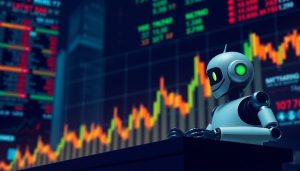Automated trading has revolutionized how investors interact with cryptocurrency and forex markets. While a free trading bot might seem like an attractive entry point for beginners and cost-conscious traders, these tools reveal significant limitations when deployed in high-volume trading environments. Understanding these constraints is crucial before entrusting your capital to automated systems, particularly when market activity intensifies.
Understanding AI Trading Bots: Definition and Basic Functionality

AI trading bots are sophisticated software programs designed to execute trades automatically based on predefined conditions and algorithms. These digital assistants constantly scan markets, analyze price movements, trading volumes, and other key indicators to identify potential trading opportunities. Once these conditions are met, the bot can place buy or sell orders without requiring human intervention.
The fundamental appeal of trading bots lies in their ability to:
- Process vast amounts of market data in milliseconds
- Execute trades with mechanical precision
- Operate continuously without fatigue or emotional interference
- Follow predefined rules consistently
Most bots rely on various analytical approaches to drive decision-making. Technical analysis bots identify patterns in price charts and indicators, while others incorporate fundamental analysis by processing news events or economic data. More advanced systems employ machine learning algorithms that continuously adapt to changing market conditions.
For cryptocurrency markets specifically, these tools provide particular value due to the 24/7 nature of trading. While human traders need sleep, bots can monitor price movements across multiple exchanges simultaneously, ensuring no potential opportunity goes unnoticed.
Benefits of Using Free Trading Bots
Free trading bots offer several compelling advantages that make them attractive entry points for many traders. The most immediate benefit is obvious – no upfront financial commitment allows traders to experiment with automation before investing in premium solutions.
Beyond cost considerations, these tools provide significant operational improvements:
- Continuous market monitoring: Bots scan markets 24/7, identifying opportunities even when you sleep
- Emotion-free trading: Algorithms execute trades based on logic rather than fear or greed
- Consistent rule application: Predefined strategies are followed without deviation
- Improved efficiency: Multiple markets can be monitored simultaneously
This emotional detachment represents perhaps the most underappreciated advantage. Human traders frequently fall prey to psychological biases that impact decision-making. Trading bots eliminate these emotional factors entirely, adhering strictly to programmed parameters.
Additionally, free bots can implement basic forms of complex strategies that would be challenging for individual traders, such as simple arbitrage between exchanges.
Critical Limitations of Free Trading Bots in High-Volume Environments

Despite their advantages, free trading bots face significant constraints when deployed in high-volume market conditions. These limitations become increasingly problematic as trading activity intensifies, often at the precise moments when effective execution matters most.
The core issue stems from fundamental resource restrictions. Free offerings typically operate with:
- Limited server resources and processing power
- Restricted API call frequencies
- Basic algorithmic capabilities
- Minimal development and maintenance support
During periods of heightened market volatility or trading volume, these constraints manifest in practical performance issues. While premium solutions leverage powerful servers with optimized code for rapid execution, free alternatives often rely on shared resources that become overwhelmed during peak demand.
Additionally, many free bots impose transaction limits or volume restrictions that directly conflict with high-volume trading requirements. These caps get quickly exhausted during active market periods, potentially leaving positions unmanaged at precisely the moments when timely execution matters most.
Technical Constraints and Performance Issues
The technical limitations of free trading bots become particularly evident during high-volume periods:
- Execution speed: Free bots typically operate with higher latency due to shared server resources
- API rate limitations: Exchanges restrict how frequently free accounts can query information or place orders
- Data processing capacity: Complex market analysis requires substantial computational resources that free platforms often cannot provide
- Connection stability: Free services rarely offer the redundant connections necessary to maintain reliable exchange communication.
These technical constraints create a compounding problem. As market volume increases, the demands on the bot’s systems intensify precisely when limitations become most restrictive. The result is a degradation of performance exactly when optimal execution is most valuable.
Strategy and Customization Restrictions
Beyond technical constraints, free trading bots often impose significant limitations on strategy development and customization options. These restrictions fundamentally limit adaptability in dynamic market conditions.
Most free bots provide only:
- Basic strategy templates with minimal parameter adjustments
- Limited indicator selection and configuration options
- Restricted access to advanced algorithmic patterns
- Minimal backtesting capabilities with incomplete historical data
This lack of customization becomes particularly problematic in high-volume environments where standard approaches may prove insufficient. Markets experiencing unusual activity patterns often require specialized strategies tailored to current conditions. Free bots typically lack the flexibility to implement these adaptive approaches.
Security Vulnerabilities and Risk Management Concerns
Security represents another critical domain where free trading bots often fall short, particularly when handling significant transaction volumes. These platforms frequently exhibit vulnerabilities that could compromise trading accounts or lead to substantial financial losses.
Common security concerns include limited encryption for API keys, insufficient protection against unauthorized access, inadequate security auditing, and delayed security updates.
Risk management capabilities are similarly restricted in most free offerings. Premium trading bots typically include sophisticated risk control mechanisms like dynamic stop-loss adjustments, position sizing algorithms, and exposure limits. Free alternatives generally provide only basic risk parameters that prove inadequate during extreme market volatility.
Practical Evaluation of Free Trading Bots
When considering whether a free trading bot can adequately handle your high-volume trading requirements, systematic evaluation becomes essential:
Performance Metrics:
- Historical performance under various market conditions
- Execution speed and slippage measurements
- Maximum sustainable transaction volume
- System reliability during peak market periods
Qualitative Assessment:
- Community reputation and user experiences
- Development team responsiveness and update frequency
- Transparency regarding limitations and constraints
- Quality of documentation and support resources
Begin evaluation with low-stakes testing in real market conditions. Deploy the bot with minimal capital across different market scenarios, particularly focusing on performance during high-volume periods.
Comparative testing provides particularly valuable insights. If possible, compare performance between free and premium alternatives using identical strategies. This direct comparison often reveals the practical impact of limitations that might not be immediately apparent from specifications alone.
Conclusion: Finding the Right Balance
Free trading bots offer legitimate value for specific trading scenarios but face substantial limitations in high-volume environments. Understanding these constraints allows traders to make informed decisions about when free tools suffice and when premium alternatives justify their cost.
For novice traders or those executing simple, low-frequency strategies, free bots often provide adequate functionality while allowing exploration of automated trading without financial commitment.
However, as trading volume increases or strategies grow more sophisticated, the limitations of free offerings become increasingly problematic. Execution delays, customization restrictions, and security vulnerabilities create compounding disadvantages that typically outweigh the cost savings.
The optimal approach often involves starting with free options to learn fundamental concepts, then transitioning to premium solutions as trading volume and complexity increase.
Best Practices for Managing Trading Bots
Regardless of whether you choose free or premium trading bots, certain management practices remain essential:
- Implement stringent monitoring systems: Never operate bots without regular oversight
- Start with minimal capital: Begin with small positions until bot performance is thoroughly validated
- Deploy comprehensive risk controls: Establish maximum drawdown limits and emergency shutdown procedures
- Maintain multiple exchange connections: Ensure redundancy in case primary connections experience issues
- Regularly audit security settings: Review API permissions and security configurations periodically
Remember that even the most sophisticated trading bots require human supervision. Market conditions evolve constantly, and strategies that performed well historically may become ineffective as conditions change.
